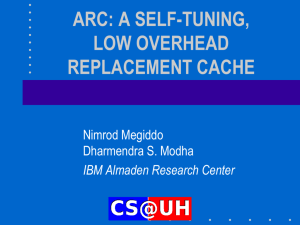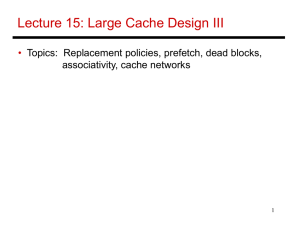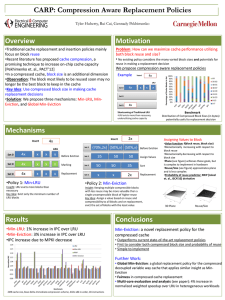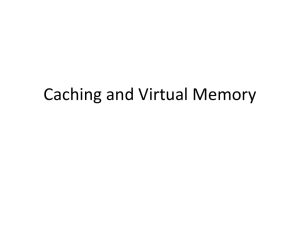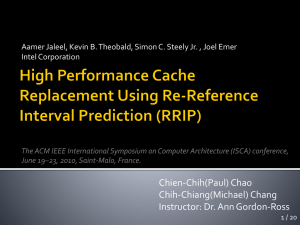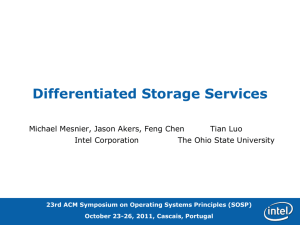13-7810-14
advertisement
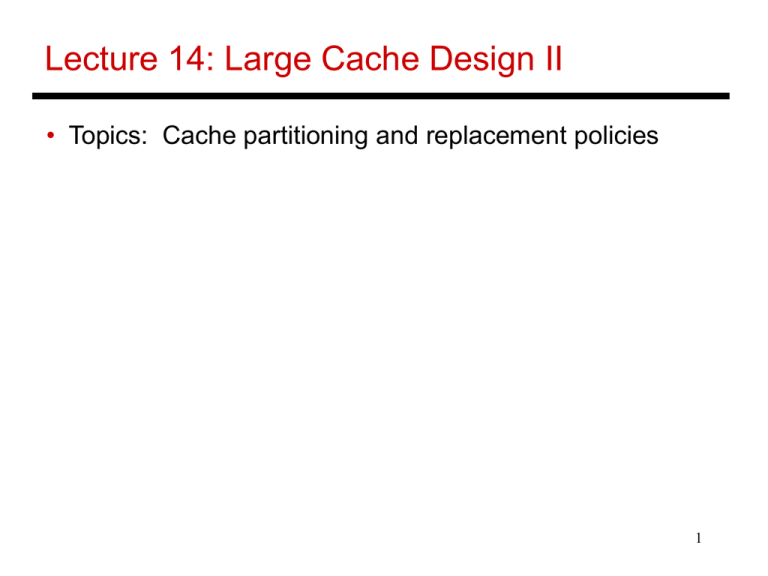
Lecture 14: Large Cache Design II • Topics: Cache partitioning and replacement policies 1 Page Coloring CACHE VIEW Bank number with Bank number with Set-interleaving Page-to-Bank Tag Set Index Block offset 00000000000 000000000000000 000000 OS VIEW Physical page number Page offset 2 Cho and Jin, MICRO’06 • Page coloring to improve proximity of data and computation • Flexible software policies • Has the benefits of S-NUCA (each address has a unique location and no search is required) • Has the benefits of D-NUCA (page re-mapping can help migrate data, although at a page granularity) • Easily extends to multi-core and can easily mimic the behavior of private caches 3 R-NUCA, Hardavellas et al., ISCA’09 • A page is categorized as “shared instruction”, “private data”, or “shared data”; the TLB tracks this and prevents access of a different kind • Depending on the page type, the indexing function into the shared cache is different “Private data” only looks up the local bank “Shared instruction” looks up a region of 4 banks “Shared data” looks up all the banks 4 Basic Replacement Policies • LRU: least recently used • LFU: least frequently used (requires small saturating cntrs) • pseudo-LRU: organize ways as a tree and track which sub-tree was last accessed • NRU: every block has a bit; the bit is reset to 0 upon touch; when evicting, pick a block with its bit set to 1; if no block has a 1, make every bit 1 5 Why the Basic Policies Fail • Access types that pollute the cache without yielding too many hits: streaming (no reuse), thrashing (distant reuse) • Current hit rates are far short of those with an oracular replacement policy (Belady): evict the block whose next access is most distant • A large fraction of the cache is useless – blocks that have serviced their last hit and are on the slow walk from MRU to LRU 6 Insertion, Promotion, Victim Selection • Instead of viewing the set as a recency stack, simply view it as a priority list; in LRU, priority = recency • When we fetch a block, it can be inserted in any position in the list • When a block is touched, it can be promoted up the priority list in one of many ways • When a block must be victimized, can select any block (not necessarily the tail of the list) 7 MIP, LIP, BIP, and DIP Qureshi et al., ISCA’07 • MIP: MRU insertion policy (the baseline) • LIP: LRU insertion policy; assumes that blocks are useless and should be kept around only if touched twice in succession • BIP: Bimodal insertion policy; put most blocks at the tail; with a small probability, insert at head; for thrashing workloads, it can retain part of the working set and yield hits on them • DIP: Dynamic insertion policy: pick the better of MIP and BIP; decide with set-dueling 8 RRIP Jaleel et al., ISCA’10 • Re-Reference Interval Prediction: in essence, insert blocks near the end of the list than at the very end • Implement with a multi-bit version of NRU: zero counter on touch, evict block with max counter, else increment every counter by one • RRIP can be easily implemented by setting the initial counter value to max-1 (does not require list management) 9 UCP Qureshi et al., MICRO’06 • Utility Based Cache Partitioning: partition ways among cores based on estimated marginal utility of each additional way to each core • Each core maintains a shadow tag structure for the L2 cache that is populated only by requests from this core; the core can now estimate hit rates if it had W ways of L2 • Every epoch, stats are collected and ways re-assigned • Can reduce shadow tag storage overhead by using set sampling and partial tags 10 TADIP Jaleel et al., PACT’08 • Thread-aware DIP: each thread dynamically decides to use MIP or BIP; threads that use BIP get a smaller partition of cache • Better than UCP because even for a thrashing workload, part of the working set gets to stay in cache • Need lots of set dueling monitors, but no need for extra shadow tags 11 PIPP Xie and Loh, ISCA’09 • Promotion/Insertion pseudo partitioning: incoming blocks are inserted in arbitrary positions in the list and on every touch, they are gradually promoted up the list with a given probability • Applications with a large partition are inserted near the head of the list and promoted aggressively • Partition sizes are decided with marginal utility estimates • In a few sets, a core gets to use N-1 ways and count hits to each way; other threads only get to use the last way 12 Aggressor VT Liu and Yeung, PACT’09 • In an oracle policy, 80% of the evictions belong to a thrashing aggressor thread • Hence, if the LRU block belongs to an aggressor thread, evict it; else, evict the aggressor thread’s LRU block with a probability of either 99% or 50% • At the start of each phase change, sample behavior for that thread in one of three modes: non-aggr, aggr-99%, aggr-50%; pick the best performing mode 13 Set Partitioning • Can also partition sets among cores by assigning page colors to each core • Needs little hardware support, but must adapt to dynamic arrival/exit of tasks 14 Overview 15 Title • Bullet 16



